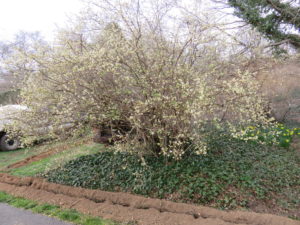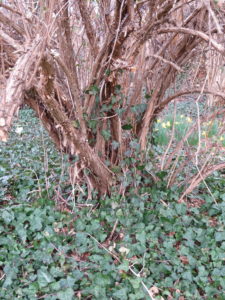Winter honeysuckle, aka fragrant honeysuckle (Lonicera fragrantissima) is a treasured old-fashioned shrub (USDA hardiness zones 4 to 8). It can still be found growing in older urban neighborhoods and parks. Winter blooming fragrant honeysuckles are a harbinger of spring. Budded branches may be cut and forced indoors.
This vigorous durable shrub grows 6 -10 feet in height and width. Many opt to limb up the lower branches to view the glossy brown wood. Its overall vigor is incredible and gardeners also choose to cut it off at the ground every 5-10 years (after blooming has finished). It is rarely sold in garden centers. Cuttings root easily and you can pass-along this heirloom shrub to gardening friends.
Frequently, here in the mid-South (zones 6 and 7), the small, creamy flowers appear during a warm spell in January – February. It continues to bloom on and off through March. The strong lemony fragrance catches your nose. The spring-summer foliage is blue green and develops little in fall color. Further south (zones 7 and 8), the foliage is almost evergreen.
Fragrant honeysuckle grows in average, dry to medium, well-drained soil, and in full sun to partial shade. Feed with 10-10-10 or equivalent granular fertilizer in early spring. Mulch honeysuckles and other spring blooming shrubs in early spring for weed management and to conserve soil moisture.
While potentially susceptible to a number of disease and pest problems, fragrant honeysuckle is very tough and outgrows most troubles. Pests include aphids, scale, sawfly, whitefly, and webworm. Powdery mildew may show up if summer weather is unusually wet. Hungry bees are especially glad to find any flowering plant in late winter days. The warm sun draw them out in search of nectar. Months later, it may attract hungry birds to the berries if any develop.
Important: Winter honeysuckle is a “true” honeysuckle. It is not listed invasive in Tennessee and Virginia, but North Carolina and Texas forbids new plantings. Since it blooms so early in the year, e.g., compared to most honeysuckle species, few fruits or seeds develop. In southern locales where winters are mild, it seeds in prolifically.
Landscape use: clipped or informal hedge, screen or background border shrub.



 Posted in
Posted in 
